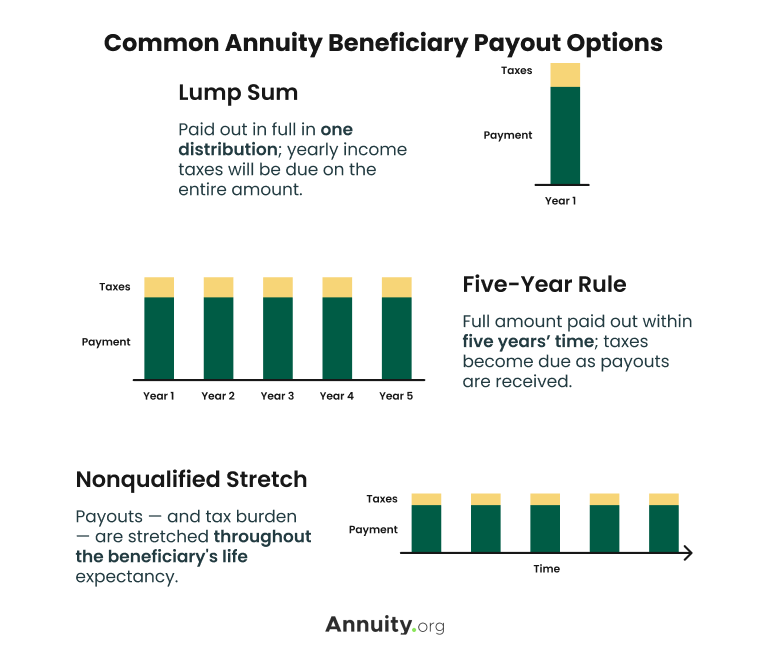All Categories
Featured
Table of Contents

Comprehending the various survivor benefit alternatives within your inherited annuity is necessary. Carefully review the agreement details or talk with an economic consultant to identify the particular terms and the ideal means to proceed with your inheritance. When you inherit an annuity, you have several options for obtaining the cash.
In some instances, you may be able to roll the annuity right into a special sort of individual retirement account (IRA). You can select to receive the entire continuing to be equilibrium of the annuity in a solitary settlement. This alternative uses instant accessibility to the funds but includes major tax obligation repercussions.

If the acquired annuity is a competent annuity (that is, it's held within a tax-advantaged retired life account), you might be able to roll it over right into a brand-new retirement account. You do not require to pay taxes on the surrendered amount. Recipients can roll funds right into an inherited IRA, an unique account specifically developed to hold properties acquired from a retired life plan.
How does Index-linked Annuities inheritance affect taxes
Other kinds of beneficiaries usually need to withdraw all the funds within 10 years of the owner's fatality. While you can not make additional payments to the account, an inherited individual retirement account provides a valuable benefit: Tax-deferred growth. Profits within the acquired IRA build up tax-free till you start taking withdrawals. When you do take withdrawals, you'll report annuity income in the exact same means the plan individual would have reported it, according to the internal revenue service.
This option provides a steady stream of earnings, which can be useful for long-term economic preparation. There are various payment choices available. Generally, you should start taking circulations no greater than one year after the proprietor's death. The minimal quantity you're required to withdraw every year afterwards will be based upon your very own life expectancy.

As a beneficiary, you will not go through the 10 percent IRS early withdrawal fine if you're under age 59. Attempting to calculate tax obligations on an inherited annuity can really feel complicated, however the core concept focuses on whether the contributed funds were previously taxed.: These annuities are funded with after-tax bucks, so the recipient usually does not owe taxes on the initial contributions, however any type of profits accumulated within the account that are distributed are subject to normal income tax obligation.
How is an inherited Single Premium Annuities taxed
There are exceptions for spouses that inherit qualified annuities. They can generally roll the funds into their very own IRA and postpone tax obligations on future withdrawals. In any case, at the end of the year the annuity business will submit a Form 1099-R that demonstrates how much, if any kind of, of that tax obligation year's distribution is taxed.
These taxes target the deceased's total estate, not simply the annuity. These taxes typically just impact very huge estates, so for most successors, the focus needs to be on the income tax implications of the annuity.
How are beneficiaries taxed on Annuity Rates
Tax Treatment Upon Death The tax obligation treatment of an annuity's death and survivor benefits is can be fairly made complex. Upon a contractholder's (or annuitant's) death, the annuity may be subject to both earnings tax and inheritance tax. There are different tax obligation treatments relying on who the recipient is, whether the owner annuitized the account, the payout approach selected by the beneficiary, and so on.
Estate Tax The federal estate tax obligation is a very progressive tax obligation (there are many tax obligation brackets, each with a greater rate) with prices as high as 55% for really big estates. Upon fatality, the internal revenue service will consist of all residential or commercial property over which the decedent had control at the time of fatality.
Any tax in extra of the unified credit rating is due and payable nine months after the decedent's death. The unified credit history will fully shelter reasonably moderate estates from this tax.
This conversation will concentrate on the inheritance tax therapy of annuities. As was the case throughout the contractholder's life time, the internal revenue service makes a vital distinction between annuities held by a decedent that remain in the buildup phase and those that have actually gone into the annuity (or payment) phase. If the annuity is in the accumulation stage, i.e., the decedent has actually not yet annuitized the contract; the complete survivor benefit assured by the contract (including any kind of boosted survivor benefit) will certainly be included in the taxed estate.
Are Annuity Income Riders death benefits taxable
Example 1: Dorothy possessed a fixed annuity agreement provided by ABC Annuity Firm at the time of her death. When she annuitized the contract twelve years ago, she chose a life annuity with 15-year duration specific. The annuity has actually been paying her $1,200 per month. Given that the contract assurances payments for a minimum of 15 years, this leaves three years of repayments to be made to her son, Ron, her designated beneficiary (Variable annuities).

That value will be included in Dorothy's estate for tax obligation objectives. Presume rather, that Dorothy annuitized this contract 18 years earlier. At the time of her fatality she had outlasted the 15-year period particular. Upon her death, the settlements stop-- there is nothing to be paid to Ron, so there is absolutely nothing to include in her estate.
2 years ago he annuitized the account choosing a life time with money reimbursement payout option, calling his daughter Cindy as recipient. At the time of his fatality, there was $40,000 primary continuing to be in the agreement. XYZ will pay Cindy the $40,000 and Ed's executor will certainly include that quantity on Ed's inheritance tax return.
Considering That Geraldine and Miles were married, the benefits payable to Geraldine represent home passing to an enduring partner. Annuity income stream. The estate will certainly have the ability to utilize the unrestricted marriage reduction to avoid tax of these annuity advantages (the value of the advantages will be listed on the estate tax form, in addition to an offsetting marital deduction)
Tax consequences of inheriting a Annuity Beneficiary
In this instance, Miles' estate would consist of the value of the continuing to be annuity payments, however there would certainly be no marital deduction to counter that incorporation. The very same would apply if this were Gerald and Miles, a same-sex pair. Please keep in mind that the annuity's continuing to be value is determined at the time of death.
:max_bytes(150000):strip_icc()/do-beneficiaries-pay-taxes-life-insurance.asp-final-7e81561536514dbdb30500ba1918afb3.png)
Annuity contracts can be either "annuitant-driven" or "owner-driven". These terms refer to whose death will certainly trigger settlement of fatality advantages. if the contract pays survivor benefit upon the fatality of the annuitant, it is an annuitant-driven agreement. If the fatality benefit is payable upon the fatality of the contractholder, it is an owner-driven contract.
However there are situations in which someone has the contract, and the determining life (the annuitant) is another person. It would behave to assume that a specific contract is either owner-driven or annuitant-driven, however it is not that straightforward. All annuity contracts released given that January 18, 1985 are owner-driven due to the fact that no annuity agreements provided ever since will be approved tax-deferred standing unless it consists of language that sets off a payout upon the contractholder's death.
Table of Contents
Latest Posts
Breaking Down Fixed Indexed Annuity Vs Market-variable Annuity A Comprehensive Guide to Investment Choices Defining the Right Financial Strategy Advantages and Disadvantages of Different Retirement Pl
Decoding How Investment Plans Work A Comprehensive Guide to Variable Vs Fixed Annuities What Is Fixed Income Annuity Vs Variable Growth Annuity? Features of Deferred Annuity Vs Variable Annuity Why Pr
Highlighting Fixed Index Annuity Vs Variable Annuity A Comprehensive Guide to Deferred Annuity Vs Variable Annuity Defining Variable Annuity Vs Fixed Indexed Annuity Benefits of Fixed Vs Variable Annu
More
Latest Posts